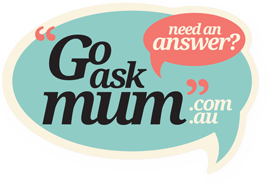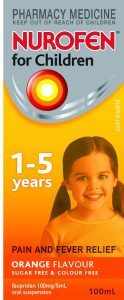When you’re a parent, it’s difficult to see your child in any form of pain. Whether the discomfort be due to fever or teething, two different pain medications that are readily available over the counter can help with symptoms.
The first is paracetamol, the second being ibuprofen. Both medications differ in how they work, how quickly they work, how long they last in the body, who they can be given to, and the risk of side effects when paired up with other ailments and medications.
Paracetamol is generally beneficial when there is a fever present. Fever, is a rise in body temperature over 38 degrees and is the body’s natural response to an infection. Low grade fevers can be treated with clear fluids such as water and making sure the child is cool and comfortable.
If necessary, paracetamol can be used to treat moderate pain and fever in children although it has minimal effect on inflammation caused by problems associated with teething in infants.
Paracetamol is usually dosed every 4-6 hours, and no more than four times a day. Check the packaging for appropriate dosage instructions for your child. If symptoms persist for more than two days it is always recommended to go and seek professional help from your local doctor to rule out anything sinister.
The effect of paracetamol is usually felt within 30 mins of treatment when taken orally.
Ibuprofen is an anti inflammatory and may work better than paracetamol when your toddler has swollen gums related with teething. Ibuprofen is usually dosed every 6-8 hours, and for no more than three times a day (check the packaging for appropriate dosage instructions for your child). Ibuprofen is not recommended for children under 3 months of age, and under a body weight of 6 kilos.
Like paracetamol, if symptoms persist for longer than two days it is recommended to make an appointment to see your local G.P.
The effect of ibuprofen is generally felt within 15 minutes of treatment. In my experiences, ibuprofen works a treat for a teething child. It acts fast and lasts longer, which comes in handy at night time.
All medicines have side effects, although you can minimise these effects by ensuring that you dose your child with the lowest appropriate dosage in the shortest period of time. Paracetamol has minimal side effects although ibuprofen may cause nausea and diarrhea in some children.
Clinical studies have proven that both paracetamol and ibuprofen act similarly when used to treat mild pain.
If children have existing conditions, such as asthma, especially when it is aspirin induced, or a heart or liver condition, they may be more susceptible to side effects and the reactions more severe. Before treating your child with any over the counter medications, you should always ensure you seek your doctors approval.
Alternating between paracetamol and ibuprofen for the symptoms of a fever is not recommended. Studies have not proven that this method is effective in treating the fever. Although, for the symptoms of general pain, it can be effective to alternate between medications as they may compliment each other. However, if pain persists for two days and over, it is always recommended to seek medical help.
What pain medication do you have in your cupboard? Which do you prefer and why?











